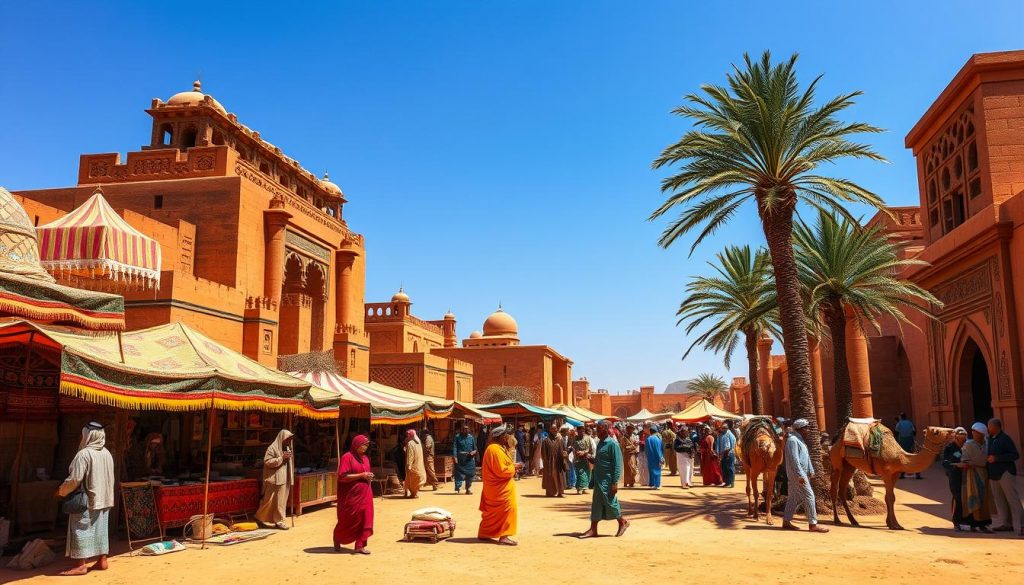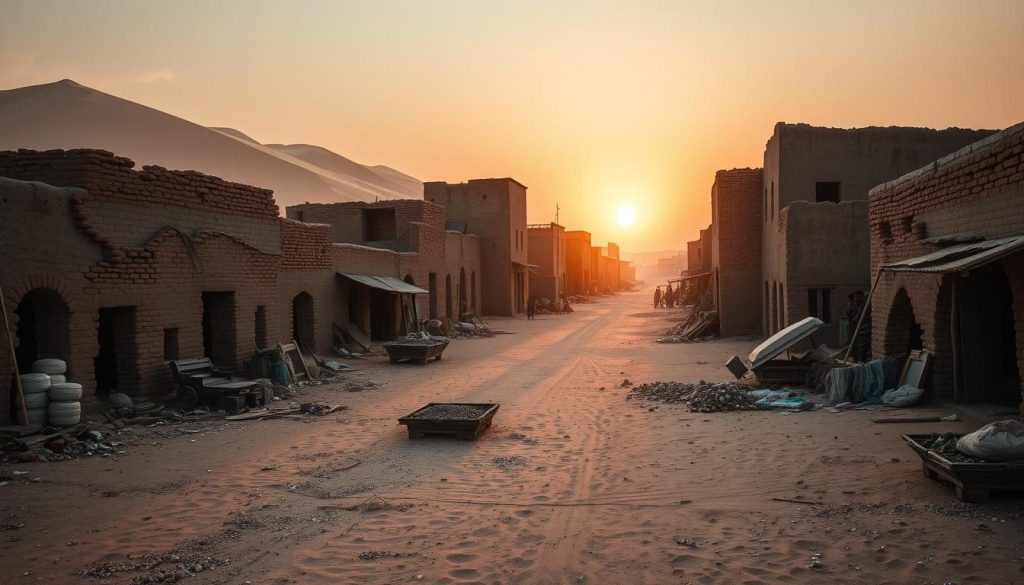The Rise and Fall of Timbuktu as a Trade Center
Timbuktu, in the heart of Mali, is a key part of African history. It was founded around 1100 CE by Tuareg herdsmen. The city became a major trade center, especially during the Mali Empire from 1240 to 1645 CE.
Anúncios
The 14th century was Timbuktu’s peak, thanks to Mansa Musa’s rule. During this time, the city’s wealth and cultural significance grew. Its location near the Niger River made it a key spot for trading goods like gold and salt.
The city’s importance was recognized worldwide. It was named a UNESCO World Heritage site in 1988. But, its heritage is facing many challenges. It was added to the World Heritage in Danger list in 2012, showing the need to save its history and culture.
Introduction to Timbuktu’s Significance
Timbuktu is a special place in history. It’s known for being a cultural hub and a key center of trade history. Founded in the early 12th century, it became a crucial link between West Africa and the Mediterranean.
It wasn’t just for trading goods. It was also a place where ideas and culture were shared. At its peak, Timbuktu had a university with about 25,000 students. This university was a big part of Islamic scholarship from the 13th to 16th centuries.
Anúncios
The city was a mix of traders and scholars. This mix created a vibrant scene of learning and business. The market drew merchants from far away, boosting local trade and culture.
Places like the Djinguereber, Sankore, and Sidi Yahia mosques show the city’s rich history. These mosques date back to the 14th and 15th centuries.
Timbuktu’s mix of trade history and learning makes it more than just a market. It’s the heart of Islamic scholarship. This mix has left a lasting impact on African history.
Origins of Timbuktu as a Trade Post
Timbuktu was founded around 1100 CE. It was started by the Tuareg nomads. They chose this spot for its strategic location. The name “Timbuktu” comes from the Tuareg phrase “Tin’Buktu,” meaning “place of Buktu.”
This early start was key to Timbuktu becoming a major trading center. The city became a vital part of the trans-Saharan trade network. It was a hub for gold, salt, and other goods.
Timbuktu’s fertile land helped its trade grow. It became a thriving agricultural area. This growth attracted more people, including merchants and scholars.
These early days made Timbuktu a place where cultures mixed. The city’s markets and resources drew many. This set the stage for Timbuktu’s future success.
The Golden Age of Timbuktu
The 14th century was the Golden Age of Timbuktu. It flourished under Mansa Musa I from 1312 to 1337. The city became a center of Islamic culture and learning.
During Mansa Musa’s rule, Timbuktu joined the Mali Empire in 1324. His pilgrimage to Mecca in 1324 made Timbuktu famous worldwide. Scholars and traders from all over came to the city.

Islamic schools thrived during this time. By the 16th century, Timbuktu had 150 to 180 Qur’anic schools. These schools were key to the city’s knowledge and learning.
The Sankoré Madrasa became a major cultural center. Mansa Musa invested in education, like the Djinguereber Mosque. He paid architect Abu Ishaq Al Saheli 200 kilograms of gold for it.
Timbuktu’s libraries were filled with private collections. These collections were crucial for sharing knowledge. Despite later challenges, Timbuktu remained a key center of learning and trade.
The city’s trade in salt, gold, ivory, and slaves enriched its culture. This made Timbuktu a significant part of history.
Expansion of the Mali Empire
The Mali Empire grew a lot from the 13th to 15th centuries. This growth helped Timbuktu become more important. The empire started before 1000 CE and grew under leaders like Sundiata Keita and Mansa Mūsā. Sundiata took control around 1230 CE, starting the empire’s growth.
By 1307, Mansa Mūsā was in power. He made the Mali Empire strong, especially through conquests. The empire controlled areas rich in gold and important trade cities like Timbuktu and Gao.
The empire’s control of trade routes made it rich. It traded gold, salt, and textiles. Timbuktu became a center of Islamic learning, attracting scholars from all over Africa.
The table below shows key achievements during the Mali Empire’s growth:
| Year | Leader | Key Events | Impact on Timbuktu |
|---|---|---|---|
| 1230 | Sundiata Keita | Gained control of the Mali Empire | Foundation for trade routes established |
| 1307 | Mansa Mūsā | Ascension to power | Strengthening of economic and cultural ties |
| 1324 | Mansa Mūsā | Pilgrimage to Mecca | Demonstrated wealth and boosted international reputation |
| 1332 | Mansa Mūsā | Territorial expansions into gold regions | Foundation for Timbuktu’s wealth and scholarly pursuit |
By the 14th century, the Mali Empire was at its peak. Timbuktu became a key center for trade. The empire’s wealth and territory made Timbuktu a place of learning. This shows the Mali Empire’s growth was more than just taking land. It was a time of great economic and cultural growth that lasted for centuries.
Timbuktu’s Transition under the Songhai Empire
The Songhai Empire’s takeover of Timbuktu was a key moment in the city’s history. After the Mali Empire’s decline, the Songhai saw Timbuktu’s value. They knew it was a key spot for trade and learning. Askia Muhammad, a leader, worked to make Timbuktu even more important.
He helped the city grow as a center of knowledge and government. Scholars and traders came from everywhere. This made Timbuktu’s culture rich and diverse.
Religion and trade were closely tied in Timbuktu. The city’s markets were full of life, with goods from all over. Islam played a big role in the city’s life and leadership.
By the early 16th century, Timbuktu was at its peak. Famous visitors like Leo Africanus saw its wealth and learning. But by 1830, René Caillié found a city in decline.
He saw crumbling buildings and a city in trouble. The city’s fall was due to less trade and weaker institutions. Despite this, Timbuktu still has many historical sites. But these sites face threats from ongoing conflicts.
| Year | Significant Event |
|---|---|
| 1526 | Leo Africanus visits and describes Timbuktu as a wealthy city. |
| 1830 | René Caillié observes Timbuktu’s decline. |
| 304 years | Duration of decline from 1526 to 1830. |
Factors Leading to Timbuktu’s Decline
Timbuktu’s glory days as a major trade center started to fade in the late 16th century. The Moroccan invasion in 1591 was a major setback. It brought many challenges that hurt the city’s culture and economy.
The Moroccan ruler was wary of smart people, leading to arrests and exile of scholars. This hurt Timbuktu’s status as a center of learning and knowledge.
Wars with tribes like the Bambara and Tuareg made things worse. These battles damaged trade routes, cutting off the wealth that once flowed into Timbuktu. Changes in global trade also played a role, as sea routes became more important, making Timbuktu less vital.
The following table summarizes key factors affecting trade in Timbuktu and their impact:
| Factor | Impact |
|---|---|
| Moroccan Invasion | Disrupted trade and intellectual stability |
| Local Conflicts | Destabilized the region and reduced economic activity |
| Shifts in Trade Routes | Decreased importance as a trade hub |
| Political Instability | Further diminished the city’s influence |
| Environmental Changes | Affected resources and livability |

Recent Historical Events Impacting Timbuktu
Timbuktu has faced a tough battle to keep its UNESCO heritage status. In the early 2000s, extremist groups attacked the city in 2012. This attack was very harmful, destroying 14 out of 16 UNESCO heritage mausoleums, which is 87.5% of them. Also, around 4,203 valuable manuscripts were lost, causing a huge cultural loss.
The world quickly reacted, with the UN passing resolutions against cultural destruction. UNESCO started campaigns to highlight the importance of these sites. They showed how vital these places are to the local community’s life and faith.
Despite the big challenges, efforts to restore Timbuktu’s heritage are ongoing. Local, national, and international groups are working together. They aim to revive cultural landmarks and rebuild after hard times.
| Year | Event | Impact |
|---|---|---|
| 2012 | Armed groups destroy mausoleums | Loss of 87.5% of UNESCO heritage sites |
| 2012 | Burning of manuscripts | Destruction of 4,203 historical documents |
| 2013 | International reconstruction conference | Pledges of $4 billion for restoration |
| 2014 | UN peacekeepers attacked | Increased scrutiny on security measures |
| 2015 | Peace accord signed | Improvement in regional autonomy |
The Cultural and Scholarly Legacy of Timbuktu
Timbuktu’s cultural legacy is deeply connected to its vast collection of manuscripts. These manuscripts are a key part of Islamic scholarship. Over time, hundreds of thousands of manuscripts from ancient empires have found a home here.
It’s estimated that around one million manuscripts have survived threats. This shows the lasting value of Timbuktu’s intellectual heritage.
Today, black families in Timbuktu own about 60 private libraries. Each library has unique texts that reflect the city’s scholarly history. The Ahmed Baba Institute, founded in 1970, is key in preserving these texts. It houses nearly 30,000 manuscripts for study and conservation.
Timbuktu’s manuscripts are more than just old books. They show how trade and knowledge interacted during the Mali Empire’s peak. Books were the most valuable trade item, with dictionaries worth as much as two horses.
Despite facing many challenges, Timbuktu’s scholars have kept their spirit alive. The Mamma Haidara Memorial Library is a recent example. It has over 9,000 ancient manuscripts, showing the city’s ongoing scholarly contributions.
The mix of wealth, trade, and knowledge has shaped Timbuktu’s history. This blend continues to be celebrated. Timbuktu’s legacy shines brightly, touching future generations.
Timbuktu History: A Summary of Key Events
The history of Timbuktu is filled with Timbuktu key historical events. It started around 1100 CE with Tuareg nomads. Soon, it became a key trading spot, known for salt and gold.
In the 13th century, Timbuktu joined the Mali Empire. Mansa Musa’s arrival in 1325 made trade boom. This led to a Golden Age, with a famous university and 25,000 students.
From the 13th to 16th centuries, Timbuktu was a hub for Islamic learning. It produced hundreds of thousands of manuscripts. These works covered many subjects, enriching Islamic and world history.
The city’s beauty is seen in three mosques: Djingareyber, Sankore, and Sidi Yahia. Built in the 14th and 15th centuries, they stand as symbols of Timbuktu’s past.
But, Timbuktu faced challenges. The Moroccan conquest in 1591 and trade route changes hurt its status. By the 20th century, it was on the List of World Heritage in Danger in 1990.
Efforts to save Timbuktu’s sites have been successful. It was removed from the endangered list in 2005. But, ongoing instability led to its return in 2012. Today, Timbuktu balances tourism and preserving its history, showing its significant milestones.
Conclusion
Timbuktu’s history is rich and full of importance. It was a major trade center and cultural hub in West Africa. At its peak, it had about 100,000 people and 25,000 scholars.
Despite facing challenges like armed conflict, Timbuktu’s legacy is still important today. It was named a UNESCO World Heritage site in Danger in 2012. This shows its global significance.
Preserving Timbuktu is key to keeping its history alive. The Great Mosque, built in 1324, shows the city’s architectural and cultural brilliance. Efforts to restore Timbuktu aim to honor its past and inspire the future.
Timbuktu’s impact goes beyond its location. It symbolizes resilience, the power of knowledge, and the importance of cultural heritage. By supporting preservation efforts, we keep Timbuktu’s legacy alive for future generations.
